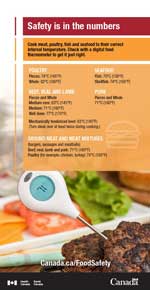Safe Cooking Temperature For Chicken
On this page
- Using a food thermometer
- Cooking temperatures chart
- Cleaning and preparation
- Poster to share
- Related
Using a food thermometer
- Insert the thermometer through the thickest part of the meat, all the way to the middle, not touching any bone.
- For burgers, insert food thermometer through the side of the patty.
- Check each piece separately if you have more than one piece.
- Use a digital thermometer for more accurate readings.
Cooking temperatures chart
| Category | Temperature |
|---|---|
| Beef, veal and lamb | |
| Ground meat (burgers, meatballs, sausages) | 71°C (160°F) |
| Pieces and whole cuts | medium-rare 63°C (145°F) medium 71°C (160°F) well done 77°C (170°F) |
| Mechanically tenderized beef and veal (turn mechanically tenderized steak over at least twice during cooking) | 63°C (145°F) |
| Pork (ham, pork loin, ribs) | |
| Ground pork (burgers, meatballs, sausages) | 71°C (160°F) |
| Pieces and whole cuts | 71°C (160°F) |
| Poultry (chicken, turkey, duck) | |
| Ground poultry (burgers, meatballs, sausages) | 74°C (165°F) |
| Frozen raw breaded chicken products (nuggets, fingers, strips, burgers) | 74°C (165°F) |
| Pieces (wings, breasts, legs, thighs) | 74°C (165°F) |
| Stuffing (cooked alone or in bird) | 74°C (165°F) |
| Whole | 82°C (180°F) |
| Eggs | |
| Egg dishes | 74°C (165°F) |
| Seafood | |
| Fish | 70°C (158°F) |
| Shellfish (shrimp, lobster, crab, scallops, clams, mussels, oysters) | 74°C (165°F) Discard any that do not open when cooked |
| Leftovers | |
| Leftovers | 74°C (165°F) |
| Hot dogs | |
| Hot dogs | 74°C (165°F) |
| Game meats | |
| Ground meat, meat mixtures, ground venison and sausage | 74°C (165°F) |
| Deer, elk, moose, caribou/reindeer, antelope and pronghorn | 74°C (165°F) |
| Large game (Bear, bison, musk-ox, walrus, etc.) | 74°C (165°F) |
| Small game (Rabbit, muskrat, beaver, etc.) | 74°C (165°F) |
| Game birds/waterfowl (wild turkey, duck, goose, partridge and pheasant) | |
| Whole | 82°C (180°F) |
| Breasts and roasts | 74°C (165°F) |
| Thighs, wings | 74°C (165°F) |
| Stuffing (cooked alone or in bird) | 74°C (165°F) |
Cleaning and preparation
- Clean your food thermometer in warm, soapy water before each use.
- Always wash your hands before and after you touch raw meat.
- Wash your hands with soap and warm water for at least 15 seconds, or with an alcohol-based hand rub.
- If you've used a plate or utensils to handle raw food, don't use them again until you've washed them thoroughly.
- Use separate cutting boards for produce and raw meat.
- Use paper towels to wipe kitchen surfaces, or change dishcloths daily. Avoid using sponges, as they are harder to keep bacteria-free.
- Sanitize countertops, cutting boards, and utensils before and after preparing food.
- Keep cold food cold and hot food hot, so that your food never reaches the "temperature danger zone" where bacteria can grow quickly and cause food poisoning.
Poster to share

Related
- Food storage
- Food safety
- Food poisoning
Safe Cooking Temperature For Chicken
Source: https://www.canada.ca/en/health-canada/services/general-food-safety-tips/safe-internal-cooking-temperatures.html
Posted by: hartleyhaddespeame.blogspot.com



0 Response to "Safe Cooking Temperature For Chicken"
Post a Comment